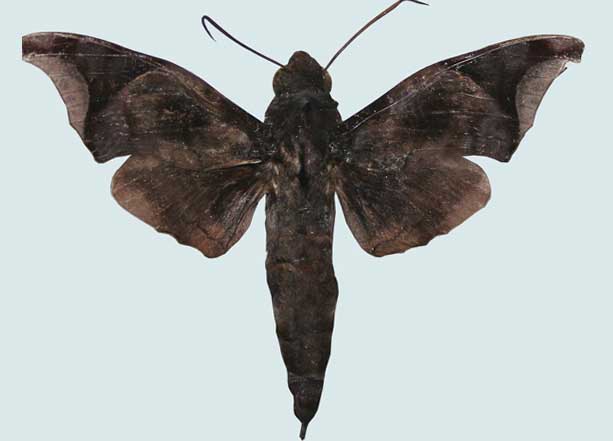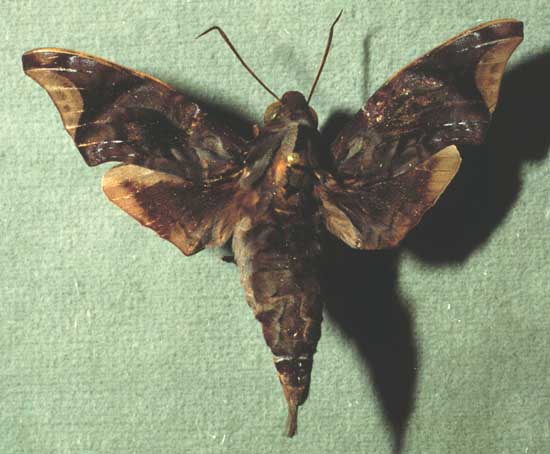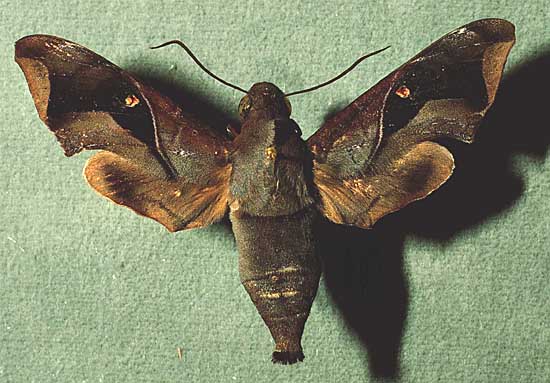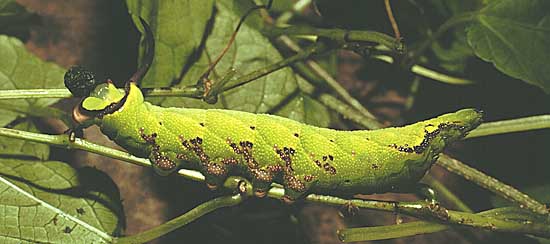
Enyo cavifer, Massaranduba, Santa Catarina, Brazil,
December 14, 2017, courtesy of Joao Amarildo Ranguetti.
TAXONOMY:
Family: Sphingidae, Latreille, 1802 |
|
|
Updated as per
AN ANNOTATED CHECKLIST OF THE SPHINGIDAE OF BOLIVIA, October 2007 Updated as per personal communication with Vladimir Izersky (Junin, Peru, January, 662m) December 22, 2008 Updated as per personal communication with Jose Monzon (Guatemala); May 2009 Updated as per CATE Sphingidae (description; Mexico, Belize, Colombia, Venezuela, Ecuador, Peru, Brazil); May 20, 2011 Updated as per personal communication with Joao Amarildo Ranguetti (Massaranduba, Santa Catarina, Brazil, December 14, 2017); March 29, 2018 |

TAXONOMY:
Family: Sphingidae, Latreille, 1802 |
I suspect it also flies in Suriname and Guyana.
In both sexes the forewing apex is truncated as opposed to sinuate as in Enyo gorgon. Ground colour is chocolate-brown, almost black in some places. The forewing discal cell is narrower than in either Enyo gorgon or in Enyo taedium taedium.
Bruno Penin reports a February flight in French Guiana.
Vladimir Izersky reports them on the wing in Junin, Peru, in January.

Enyo cavifer male, Coviriali, Junin, Peru,
January 7, 2008, 662m, courtesy of Vladimir Izersky.


This site has been created by Bill Oehlke.
Comments, suggestions and/or additional information are welcomed by Bill.
Larvae feed on Cissus aff. biformifolia, Vitus tiliifolia and other members of the Vitaceae family.This one was "caught in the act." |  |
Return to Sphingidae Index
Return to Dilophonotini Tribe
Use your browser "Back" button to return to the previous page.
This page is brought to you by Bill Oehlke and the WLSS. Pages are on space rented from Bizland. If you would like to become a "Patron of the Sphingidae Site", contact Bill.
Please send sightings/images to Bill. I will do my best to respond to requests for identification help.
Enjoy one of nature's wonderments: Live Saturniidae (Giant Silkmoth) cocoons.
 Show appreciation for this site by clicking on flashing butterfly to the left. The link will take you to a page with links to many insect sites. |